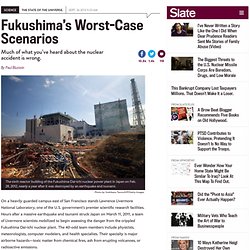

Ocean gyres. Fukushima disaster: New information about worst-case scenarios. Photo by Yoshikazu Tsuno/AFP/Getty Images On a heavily guarded campus east of San Francisco stands Lawrence Livermore National Laboratory, one of the U.S. government’s premier scientific research facilities.

Hours after a massive earthquake and tsunami struck Japan on March 11, 2011, a team of Livermore scientists mobilized to begin assessing the danger from the crippled Fukushima Dai-ichi nuclear plant. The 40-odd team members include physicists, meteorologists, computer modelers, and health specialists. Their specialty is major airborne hazards—toxic matter from chemical fires, ash from erupting volcanoes, or radioactive emissions. The scientists’ work—secret at the time and barely known to the public even today—had an enormous impact on Japan’s nuclear crisis, averting a potentially disastrous U.S. overreaction. Photo by Asahi Shimbun/Reuters President Obama's top science advisers turned to Livermore to determine the extent of the peril to the Japanese archipelago. TEPCO releases water deposited by typhoon at Fukushima plant. Tokyo Electric Power Co. said it released 1,130 tons of water left behind by powerful Typhoon No. 18 on Sept. 16 onto the soil of the crippled Fukushima No. 1 nuclear power plant after determining contamination levels were below safety standards.

The rainwater collected behind seven concrete barriers, each enclosing a group of storage tanks holding radioactive water on the grounds. The utility said its workers took the "emergency measure" after confirming that the water in each area contained lower radioactive strontium levels than the legal limit. TEPCO said it decided to drain the water because if another leak occurred in the storage tanks and went unnoticed, it could contaminate the rainwater accumulated inside the enclosure. Each concrete barrier in the enclosure is about 30 centimeters high and is equipped with a drainage valve.
Stunning Story from a Fukushima Daiichi Nuclear Power Plant Worker By OSHIDORI MAKO. May 27, 2013 Mako Oshidori of Yoshimoto Creative Agency is a member of the Manzai Kyokai (The Association for Stand-up Comedians) and of the Board of Directors of the Free Press Association of Japan.

She regularly attends press conferences given by public authorities and TEPCO since the outbreak of the Great East Japan Earthquake. She also relentlessly does reporting on Fukushima and other disaster-affected areas. She presently writes columns for “DAYS JAPAN” and “MAGAZINE 9”. For donations, please go to the link below: Thank you for your support! Excerpt from column #57 “Iwakino Mama Tachi to Chikachosuisou to Sagyoin no kata no Ohanashi no Ken” literally, “About mothers in Iwaki, underground water tank and stories from a worker” of “Datsutte miru?”
Stunning Story from a Fukushima Daiichi Nuclear Power Plant Worker I heard a stunning story which made me think that the leak of concentrated salt water from an underground water storage tank is a relatively minor accident. – Are you serious? A Visual Tour of the Fuel Pools of Fukushima. Do You Know What the Fuel Pools Actually Look Like? You already know that Fukushima’s fuel pool number 4 may be the single greatest threat , but that pool number 3 is very dangerous as well. You’ve heard that unit 3′s fuel pool contains less radioactive material than unit 4 … but still a tremendous amount of radiation. Scientific American reported last year: The pools at each reactor are thought to have contained the following amounts of spent fuel, according to The Mainichi Daily News : • Reactor No. 1: 50 tons of nuclear fuel • Reactor No. 2: 81 tons • Reactor No. 3: 88 tons • Reactor No. 4: 135 tons • Reactor No. 5: 142 tons • Reactor No. 6: 151 tons • Also, a separate ground-level fuel pool contains 1,097 tons of fuel; and some 70 tons of nuclear materials are kept on the grounds in dry storage.
You’ve learned that unit 3′s reactor was the only one at Fukushima which burned plutonium . Reactor 3 … uses highly dangerous mixed oxide fuel, Tokyo Electric has reported. The REAL Fukushima Danger. Symposium Update: online archive now available at live stream link. Online permanent archive available now: Thanks to all who attended the symposium in person, and the over 4300 more in 650 cities around the world who attended online.

We have had many requests and questions for/about the online archive. It is now up at the Live Stream link: . Click on presenter names to go directly to any individual presentation. Click on Documents to access available power points. Please share widely, but remember to give proper attribution to the speakers and their colleagues if that has been requested. We are pleased to make this permanent archive available for free, but we still have work we would like to do. Symposium UPDATE 3/7- Press conference: There will be a press conference 1:00 pm on Monday, March 11 with US Navy Quartermasters (retired) Maurice Enis and Jaime Plym who both suffered radiation exposure and subsequent health damage while serving on the USS Ronald Reagan during a Fukushima aid and rescue mission. Update: Live stream link will be: